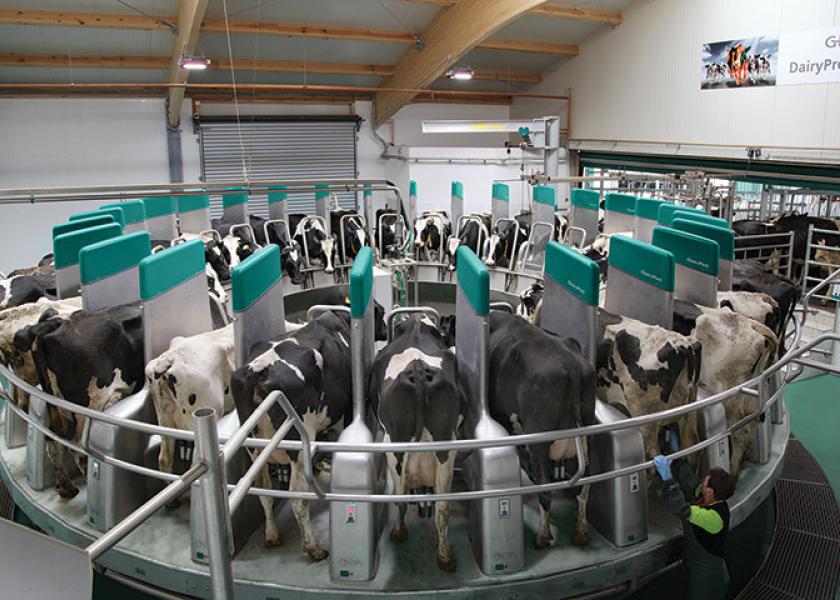Automatic Milking: Wunderbar

Globally, finding people who want to work on a dairy can be challenging, especially in more developed countries. Thanks to new, innovative, fully-automated technologies being tested on German farms, it appears fewer people in the parlor could be a case of less is more.
Agrargenossenschaft Teichel e.G. has been a cooperative farm since 1953 and sits on the outskirts of a village called Teichröda. The 4,500-acre operation includes row crops, hogs, poultry and beef cattle. The primary livestock for the farm can be found in the new, green free-stall barn housing 400 Holstein cows.
Eckhardt Blöttner serves as manager of the farm and its 38 employees. With that kind of workforce, it can be challenging to find employees who want to do day-to-day labor—particularly milking cows.
A new parlor was needed to help further improve the efficiency of workers and production of cows. Plans were made to construct a 40-stall rotary parlor to replace the aging, double five-tandem milking parlors.
With the help of a local equipment dealer, Eckhardt was asked if he’d be interested in trying a developing parlor technology: DairyProQ. GEA’s DairyProQ is an automatic milking system that features individual robotic modules for each stall on the rotary.
DairyProQ went fully operational on June 16, 2014, at the farm, and now, it milks approximately 200 cows per hour at one site with three milkings per day.
Eckhardt believes the change in milking systems and housing facilities has helped improve the health status in the cows while also increasing daily yield.
“We started with a herd average of 62 lb. per cow per day. We now milk 73 lb. per cow, and the high-yielding group has a daily milking of 93 lb.,” Eckhardt says.
Cows went into the free-stall barn with an average somatic cell count of 260,000 cells/mL. After adjusting to the new facilities, somatic cell counts dropped to 90,000 cells/mL.
The change in milking systems has afforded more time to focus on other duties around the farm. Typically, two employees are present at the dairy during an eight-hour shift along with the herd manager. Now, only one person needs to be in the parlor to ensure no cows are missed because of undesirable teat formation.
The change to automatic milking has been groundbreaking, but farming in eastern Germany has seen many shifts since World War II. There was the rise of communism, where farms employed hundreds of workers in a state-mandated system. The fall of the Berlin Wall led to restructuring as Germany became one country again.
The remnants of the old communist regime are still evident at the farm. Soviet-style barns made entirely from concrete stand near the mess hall that would have served more than 500 workers meals each day. Just to the northwest of those grey, concrete creations stand several new green tin barns reminiscent of many dairies in the midwestern U.S. and a sign of a more capitalistic future.
In 1991, after the reunification of Germany, there were still 420 employees working for the 503 member-owned cooperative. The following decade, the operation became more efficient, dropping down to 49 people by 2002. Today, there are 38 employees serving the 139 member owners of the farm.
Eckhardt’s son, Stefan, thinks milking the cows is now the easy part of the job at the farm. “We just open the door, and the cows walk in,” Stefan says of the new rotary.
Along with helping out at the dairy, Stefan also works for the state of Thuringia’s farmers association and holds a Ph.D. in dairy genetics. With his background in genetics, Stefan is interested in the data he can receive back from the system to help breed a more healthy and profitable cow.
Each if the 28 stalls of the DairyProQ rotary has the capability to individually track cow production with activity monitors or identify cows with an RFID ear tag.
A producer can easily troubleshoot problems with the modules by communicating wirelessly to individual stalls. Each DairyProQ installation has two or three extra stalls that can be installed if an arm or computer goes down.
“Automatic milking is the future,” Stefan says. “There is no way we’re going back to milking by hand.”
The Blöttners aren’t the only producers who have been impressed with the results they’ve seen switching to an automated rotary. Andreas Polster serves as facility manager of Landwirtschaftsgenossenschaft e.G. Ottendorf/Krumbach, a 530-cow dairy that just installed a 28-stall DairyProQ rotary.
“The aim was to make a better place for the cows and employees,” Polster says. The hope is for the parlor and barns to continue being in use 25 years from now.
The Ottendorf/Krumbach farm has similar Soviet-style barns where the cows were housed until the new free-stall was opened on February 28 and milking began in the rotary.
Currently, 15 employees work on the farm specifically related to dairy production. In the future, it will likely be 13 workers.
Polster admits the cows had a bit of an adjustment period in the new barn going from a straw-bedded tie-stall to free-stall mattresses. Brushes will be installed later to help add more comfort to the cows.
After about four months, the Holstein herd is averaging approximately 64 lb. of milk per day in the new facilities, 4.5 lb. less than the old barns. Polster believes the drop in production might be related to the lack of a concentrate being fed on the rotary.
The cost of installing a DairyProQ rotary would be roughly three-times a standard rotary parlor. Federal/state subsidies were available for the dairy in Teichröda to help pay 30% of the installation through a milk program.
There are no DairyProQ parlors in the U.S. yet, but North America should have an automated rotary operational in western Canada by the end of the year.







